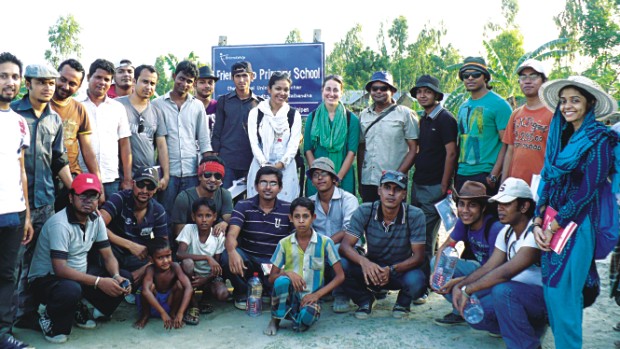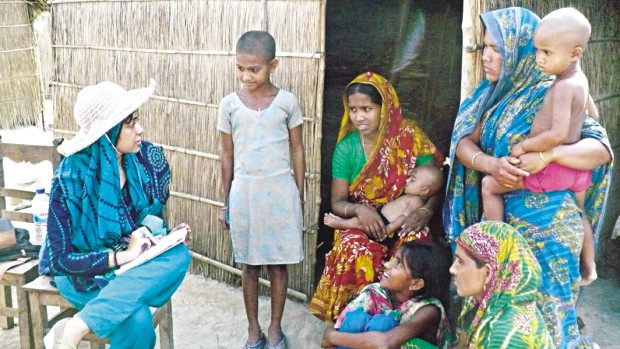| Home - Back Issues - The Team - Contact Us |
 Linking Young Minds Together |
| Volume 3 | Issue 19 | May 15, 2011 | |
|
Spotlight
Promity Prova Chowdhury Photo: Students and faculty members who visited the chars. Imagine a thatched hut, stalk of hay, red chillies spread in the yard, women making fire in a mud-built furnace, children playing all around, a girl feeding the cattle, an old man smoking the hookah -- a typical village scene in Bangladesh. But what if, this scene is destroyed every year, sometimes twice, thrice or even more in a year? That's life on the shores. Then how do people living on the shores, or, chars, survive?
To know the answer, 26 students of the University of Liberal Arts Bangladesh (ULAB) set out for Gaibandha on a three-day field trip on April 20, 2011. The trip was arranged by ULAB-ISD (Institute for Sustainable Development) which is a proposed research institution in ULAB, motivated by social responsibilities, moral concerns and socio-environmental challenges. Its vision is to provide present and future generations with relevant knowledge and expertise for a better citizenship both in Bangladesh and the global world. It aims to execute interdisciplinary research in diverse areas that cover socio-environmental issues and for such a research, this trip was arranged.
Students from three courses, “Seminar on International Grassroots Development,” “Introduction to Community Development” and “Environmental Impact Assessment” visited the chars to do the research work. These are some of the GED (General Education) courses existing in ULAB under the ULAB-ISD. This trip was part of the course curriculum and the final project of each course was depending on it. Though grades mattered here, the learning part was way more important as this was a unique opportunity to learn from practical experience. Interestingly, three enthusiastic students who do not belong to any of the courses had also joined the research team. The goal of this research was to understand the different livelihood activities of the char dwellers throughout the year, their disaster preparedness, the moving process due to natural disasters, the complexity that they face to have access to lands, in short, to understand the evolution of life in the chars.
After the tiring sleepless journey by bus, the team arrived at Hotel North Bengal, the boarding house in Gaibandha town, arranged by the Friendship NGO. Dr Rathana Peou Van den Heuvel, instructor for the course “Seminar on International Grassroots Development” and Deputy Director of ULAB-ISD along with Ehsanul Kabir, instructor for the course “Introduction to Community Development” and “Environmental Impact Assessment” were the trip co-ordinators. After arriving at the hotel we met Marie Pierre Arseneault, Researcher, Asian University for
Women, who after a brief period of relaxing, took us to the Freindship office where she gave us details on our activities. She prepared nine sets of questionnaires for conducting case studies and instructed us how to talk to the beneficiaries, what to do and what not. We were divided into groups of three to conduct each case study by talking to three different beneficiaries. So each team had to have 27 beneficiaries which included men, women, elderly people and children. Immediately after the instructions were given out, we set out for the ghat on the “tomtom” (Gaibandha's battery run scooter). Everyone was busy with putting on
sunscreens and hats as the scorching heat was awaiting us. Some seemed sad because their cell phones were out of battery and thanks to the unpredictable fluctuation of electricity voltage in Gaibandha, not to mention the long hours of no electricity as well, there was no way to charge the phones right then. The 40-minute journey by trawler on the crossings of rivers Brahmaputra, Jamuna and Tista took us to our destination for our first day of work -- Shidhai Char.
Our job was to go door to door and talk to people. It was 12 at noon, which was why the men were absent in most of the homes. We explored their cultural specificities and the reality of the young people living there. These people are not at all sure about their age or the years they shifted or faced natural calamities. The rate of child marriage is extremely high here. Almost all the girls around the age of 14 are married and have children.
On our second day, we felt strangely recharged and ready to visit more chars. Our destination for the day was the Vaitkamari Char. This time we were more organised and discovered many new perspectives in the research. We saw the Friendship Primary School there and talked with many children. The villagers were very hospitable. We were instructed to be very conscious while talking to them because it was their territory and they might not be very co-operative. But surprisingly these char dwellers were very welcoming and shared all there sufferings, struggles as well as achievements. ON the last day of the trip we did some FGDs (Focus Group Discussions) with the women and men of the Kalashona Char separately, which brought in front of us a scenario of how men and women worked hand-in-hand during the calamities. When disaster occurs the whole village becomes a family. Women, for example, with husbands working outside the char or abandoned, get all kinds of support from the villagers and NGOs.
“Trips from the university are always fun. But this trip was so much educative than any other as it took us to the actual 'grassroots' and we experienced the reality of these people,” says Tania Ferdous, a student from the course “Seminar on International Grassroots Development." Education is not a one-way communication. Today education means active learning and a whole lot of interaction with the outside world and such field trips are excellent practices of making students strong and practical before hitting the real world. These trips also create
strong bonding between the faculties and students. The students can also showcase their talents and ideas outside the classroom, which sometimes are not possible inside. Moreover the “development” related courses are never complete or successful without field trips. This trip was a scope of enrichment for both the students and faculties. The students not only helped the researchers, who are faculties of ULAB as well, but also gained an experience of a lifetime. (The writer is a student of Media Studies and Journalism at ULAB.) Moving on with Life 35 year old (approximately), Rawshan Ara had come to the Vaitkamari Char 20 years ago from Rahmatpur Char due to river erosion. She has two children, a son who is a Higher Secondary Certificate (HSC) candidate and a daughter studying in class two. "In Rahmatpur I had to move three times due to natural disasters," she says. "When I finally shifted here with my family, this place was nothing but a jungle. It took a lot of effort to make this place liveable. The son of the land owner tried to remove us from this territory. Almost one bigha of land was snatched from us.” When asked about the written documents of land she said they don't have any till now. “The suffering during flood is indescribable here," she adds. "Previously the scenario was worse when we had to live on the roof during the flood. We had a furnace but nothing was there to cook. Now as the NGOs have made a flood centre and also have taken measures to avoid frequent soil erosion, the situation is a little better. However, we would have to move again if there is a big storm in the future. I want my son to grow up, get well educated and live a stable life in the mainland.” Dreams on the Char Mosammat Shahana Khatun, a student of Class 9 in the Friendship Primary School at the Vaitkamari Char, unveils a different side of the story. According to her, education makes all the difference. She speaks about the cultural programmes that they hold in their school. On Pahela Boishakh they arrange all kinds of performances -- songs, dances and dramas. They also have jatras and other musical ceremonies once a month. They also have sports like ha-do-do matches now and then. There are 40/50 houses in this village and 8/9 houses have televisions. Cell phones are available here but there are no newspapers due to the lack of proper infrastructure. The women are well-engaged in activities outside the house as well, with gardening and farming. They are quite skilled in sewing and knitting as well. But Shahana regrets that due to poor infrastructure, the valuable productions of this char, like, the crops and handicrafts, are not going outside to the mainland. She says that the major advantage in the mainland is that people can study there without any disruption. But here, every now and then the flood occurs and the school building becomes the rehabilitation centre. That is when studies are tremendously hampered. Copyright (R) thedailystar.net 2011 |
||









